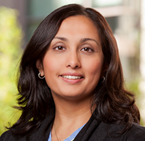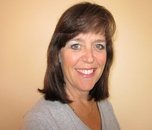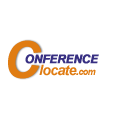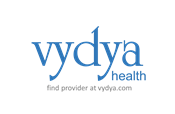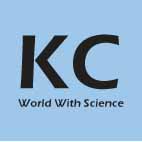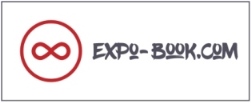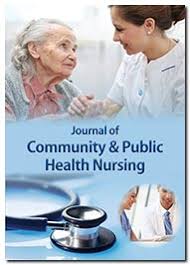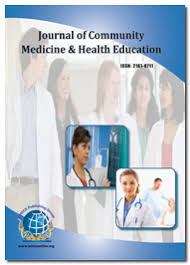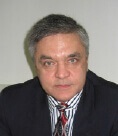Theme: Advancement in Public Health by integration of Community Nursing Practices
Community Nursing 2018
- About Community Nursing and Public Health 2018 Conference
- Sessions/ Tracks
- Market Analysis
- Past Conference Report
Community Nursing 2018 is extremely pleased to welcome you to the “International Conference on Community Nursing and Public Health” to be held on November 19-21, 2018 in Cape Town, South Africa. The theme of the conference is “Advancement in Public Health by integration of Community Nursing Practices”. This conference aims to bring together individuals and organizations from varied fields of healthcare and provide a global platform for the exchange of innovative ideas thereby benefiting the global scientific community. As global healthcare faces newer challenges every day it is a prime time to unite and salute those who work endlessly to combat these threats.
Scope and Importance
Community Nursing 2018 is an emerging platform for outstanding research work to bask in the global spotlight and it aspires to bring about revolutionary changes in the field of Public Health by sharing of ideas, knowledge, practical on field experience, entrepreneurial opportunities and exclusive research work to benefit the global Public Health standards by inclusion of Community Nursing practices to tackle Public Health issues. This year’s conference is being organised in South Africa. In a recent independent study, South Africa was ranked last among 19 nations (which included countries like France, the US, Argentina, United Arab Emirates, China and Brazil) in a global survey that measured healthcare system efficiency. Thus it leaves room for plenty of improvement in this sector. But despite the health index’s worrying findings, South Africans perceived health care much more positively than what actually happened on the ground. South Africans believe themselves as having greater access and integration of the healthcare system than they have in reality. Most South African also believed their health condition to be better than it actually was. The majority (80%) of the subjects rated their current health positively, with either a good, very good or excellent score. At the same time, just one third (33%) of healthcare professionals agree that the overall health of the population in South Africa was positive.
Why Attend???
Community Nursing 2018 provides an unmatched opportunity for nursing practitioners, healthcare experts, public health organizations, clinical researchers, academics, physicians and students to meet and network with famous individuals and organizations from their respective fields and to get useful insights in the latest clinical researches. This kind of event encourages medical professionals of all levels of experience to participate in an interactive educational growth environment that is not easily found within the confines of one's workplace. Besides South Africa is one of the most beautiful places on the continent of Africa and they leave no stone unturned to indulge their guests.
Target Audience
Leading Nurses from all over the world, Physicians, Emergency Healthcare Professionals, Public Health Workers, Nursing Educators, Professors, Research fellows and many more from leading universities, Directors and members of Associations and Societies, Leading Healthcare Companies and Medical Research institutions, Hospitals, Researchers sharing their novel researches in the area of Community Nursing, Healthcare & Medicine, Emerging Entrepreneurs, Students.
Sessions Related to Community Nursing 2018 Conference
TRACK 1: Community Nursing
Nurses have always cared for individuals, families and communities in their practice. Recently, there has been an increase in the number of nurses working outside the hospital, primarily in community-based settings that focus on individuals and families. There is also increasing emphasis on community-focused nursing care with the community as the client. Moreover, public concerns regarding quality, cost, access and fragmentation of health care have contributed to a shift in care from the more traditional acute care settings to the community. This has led to changes in nursing practice. Changing demographics, changing disease patterns, an increase in chronic illnesses resulting in underestimated health-care expenditure, a reform in the health financing system, and a renewed focus on health promotion open up new opportunities for providing community-based care in community settings. Healthcare in the context of the community represents an alternative mode of health-care delivery. Emphasis is placed on promoting health and access to care by addressing the health-care needs of people where they live and work. Moreover, local community needs, resources and preferences of the people drive community health services. In any country, the health services/family health/disease prevention and health promotion provided to the community are delivered through the available community health service system.
TRACK 2: Nursing Education
Practical nursing, the most basic level of nursing practice, began with the industrial revolution of the late 1800s. To meet labour workforce demands during this time, many people moved from rural areas to urban areas. Women needing employment often provided domestic services, including those associated with caring for the sick. To support the skills of this new healthcare provider, in 1892 the Young Women’s Christian Association (YWCA) located in Brooklyn, New York, offered the first formal practical nursing course. Over time, landmark reports about the state of nursing education contributed to the development of practical nursing programs. Since the first half of the 20th century, the scope and function of practical nurses have become increasingly sophisticated. They are licensed to practice either as licensed practical nurses (LPNs) or as licensed vocational nurses (LVNs), and they work under the supervision of registered nurses. Nurse practice acts for the practical nurse vary from state to state, but generally, the practical nurse is responsible for stable patients and patients with common health conditions. They also are responsible for collecting and reporting abnormal data, offering suggestions for developing and changing nursing care, providing bedside care, teaching health maintenance, and participating with the healthcare team in evaluating nursing care.
TRACK 3: Community Midwifery and Pregnancy
Community midwifery practice is woman oriented and focuses on excellence in the processes and provision of women’s health care, with a primary goal of improving maternal and child health. Community midwives promote the discipline of midwifery through professional actions that benefit women and their families while allowing adequate personal time for reinvigoration for this important work. Midwives are blessed with a passion for their work. It is the thoughtful and skilled expression of this passion that women under midwives’ care so appreciate and that has helped the discipline of midwifery to thrive. Traditional midwifery care is based on providing care that fosters the physiologic processes of labour and birth. Modern midwifery and women’s health care builds on this physiologic non-interventionist foundation to include interventions only as necessary and as indicated by the individual woman’s condition and preferences. Determining which interventions are “necessary” and when they are “indicated” defines our individual practice as midwives yet can also be a function of the environment of care in which the midwife practices.
TRACK 4: Public Health
Public health is compressive in scope. It relates to or encompasses all community and individual activities directed towards reducing factors that contribute to the burden of disease and foster those that relate directly to improved health. Its programs range from Immunization, health promotion, and childcare to food labelling and food fortification to the assurance of well-managed, accessible health care service. The planning, management, and monitoring functions of a health system are indispensable in a world of limited resources and high expectations. This requires a well-developed health information system to provide the feedback and control data needed for good management. It includes responsibilities and coordination at all levels of government and by non-governmental organizations (NGO’S) and participation of a well-informed media and strong professional and consumer organization. No less important are clear designations of responsibilities of the individual for his/her own health, and of the provider of care for human, high-quality professional care.
TRACK 5: Nursing Management
The function of administration is an essential factor in the development of any service. It provides the mean whereby the most effective use can be made of the knowledge and skills of those giving the service. The advancement in the art of administration is comparatively less than that of nursing services. Indeed, there is ample evidence from studies, which have been made in many countries that better use can be made of the skills acquired and of the energy and enthusiasm of the men and women who make up the nursing team. Unless the training of the professional nurse includes a study of administrative practice, when she reaches a position of authority, she is ill-prepared, for it. It must be remembered that administrative practice is not confined to the top level of authority, that all who occupy positions, which call for the planning and direction of the work of others need to exercise administrative skill.
TRACK 6: Paediatric and School Nursing
The nurse preparing to care for today’s and tomorrow’s children and child-rearing families faces vastly different responsibilities and challenges than did the paediatric nurse of even a decade ago. Nurses and other health professionals are becoming increasingly concerned with much more than the care of at-risk and sick children. Health teaching; preventing illness; and promoting optimal (most desirable or satisfactory) physical, developmental, and emotional health have become a significant part of contemporary nursing. Scientific and technological advances have reduced the incidence of communicable disease and helped to control metabolic disorders such as diabetes. As a result, more health care is provided outside the hospital. Patients now receive health care in the home, at schools and clinics, and from their primary care provider. Prenatal diagnosis of birth defects, transfusions, other treatments for the unborn fetus, and improved life-support systems for premature infants are but a few examples of the rapid progress in child care.
TRACK 7: Occupational Health Nursing
Occupational health nursing is a varied and specialized nursing practice in which occupational health nurses (OHNs) use their wide base of knowledge and skills to care for individuals in the workplace. Occupational health nurses can also make a major contribution to the sustainable development, improved competitiveness, job security and increased profitability in enterprises and communities by addressing those factors which are related to the health of the working population. By helping to reduce ill health occupational health nurses can contribute to the increased profitability and performance of organizations and reduce health care costs.
TRACK 8: Family Nursing and Healthcare
Family health care nursing is an art and a science that has evolved as a way of thinking about, and working with, families when a member experiences a health problem. Family nursing comprises a philosophy and a way of interacting with clients that affect how nurses collect information, intervene with patients, advocate for patients, and approach spiritual care with families. This philosophy and practice incorporate the following assumptions: health affects all members of families, health and illness are family events, and families influence the process and outcome of health care. All healthcare practices, attitudes, beliefs, behaviours, and decisions are made within the context of larger family and societal systems. Families vary in structure, function, and processes. Families even vary within given cultures because every family has its own unique culture. People who come from the same family of origin create different families over time. Nurses need to be knowledgeable in the theory of families, as well as the structure, function, and processes of families to assist them in achieving or maintaining a state of health.
TRACK 9: Geriatric Nursing
There are many reasons why people are living longer. Advances in medications to treat diseases, immunizations to prevent disease, and new diagnostic techniques to assist in the early detection and treatment of disease are among the major reasons for the increase in longevity. The development of new medications occurs daily and aids in the treatment of illnesses that once resulted in disability and death, such as heart disease and cancer. Moreover, the ability to prevent diseases such as measles, mumps, rubella, chicken pox, and polio plays a great role in allowing children and young adults to enter older adulthood. In addition, improved economic conditions and nutrition, as well as a stronger emphasis on health promotion, have undoubtedly resulted in decreases in both illness and death among the population. Many theorists have questioned the key ingredients to living a long life.
TRACK 10: Environment, Health and Safety
Environmental factors like poor water quality and access, exposure to toxic chemicals, vector-borne diseases, air pollution, climate change and degrade urban environment are all highly responsible for death and disability. Statisticians estimated the global death and disease rate due to pollution at 25% and even reaching up to 35% Sub-Saharan-Africa. This has a greater effect on the poor population of developing nations. A large number of these deaths can be avoided as many of these diseases can be prevented. However, effective action requires to be renewed moral commitment to sustainable development and determined political action through partnerships. Together we must translate our global knowledge on environment and health linkages into practice and action at the country level, incorporating environment and health considerations into economic, social and political decisions.
TRACK 11: Ambulatory and Emergency Care Nursing
There is increasing recognition of the need to develop urgent care outside traditional hospital settings. New models of service delivery have the potential to achieve excellent and efficient care close to, or even in, the patient’s home. This allows our urgent care system to be more tailored to patient needs and preferences, enhancing the experience and preserving hospital beds for those with the most serious and complex problems. However, there is still much to do, and many more patients who could receive care in more convenient and effective ways, closer to home. Hospital admission should be reserved for the most severely ill and injured patients, who need the concentrations of expertise and high dependency care that hospitals can provide. For the majority, ambulatory emergency care should become routine, however, this can only be achieved where it proves possible to implement whole system integration and coordinated care, supported by new technologies, rapidly accessible diagnostics and a workforce that has the necessary knowledge and skills.
TRACK 12: Military and Combat Nursing
Nurses have served the Armies of the world proudly during war and peace. Wherever duty called the fighting man, it also called the Army nurse. Following every major training exercise, every deployment for combat experience. While nearly everyone acknowledges the general value, few fully appreciate the concept and process involved. Military nursing innovation as a term has been so overused and misused that it has resulted in a variety of meanings. While for some the term means simply observations, and others apply it broadly to any innovative and potentially performance-improving idea. Starting with World War II and proceeding through the most recent conflicts, examination of available data proved that nursing activities during all conflicts could be placed into four categories: training or preparation, living and working conditions, innovations or improvisation, and redeployment or "going home".
TRACK 13: Epidemiology Nursing and Impact on Public Health
Descriptive epidemiology is concerned with both the frequency and distribution of a health outcome (or health-related exposure). In other words, how common is it, and who does it affect? The first question can be answered using measures such as incidence and prevalence. The second can be framed in terms of TIME, PLACE and PERSON. For example, we may describe the distribution of health outcomes by age, population, geography or over time. In his treatise ‘On Airs, Waters, and Places’, Hippocrates (460BC–377BC) recognized the importance of the environment in the causation of disease. Epidemiology as a discipline developed in the area of infectious disease control, through the statistical analysis of routine data to quantify the risk associated with unsanitary environments. The epidemiology of communicable disease and its application to Public Health is sometimes also known as ‘Health Protection’ (something of a misnomer given that all epidemiology is about protecting health through identifying and limiting exposure to risk factors).
TRACK 14: Community Mental Health and Psychiatry
Psychiatric-mental health nursing is the nursing practice especially committed to promoting mental health through the diagnosis, assessment, and treatment of mental disorders, behavioural problems and comorbid conditions across the lifespan. Psychiatric-mental health nursing intervention is the art and a science, employing a purposeful use of self and a wide range of psychosocial, nursing, and neurobiological evidence to produce effective outcomes.
TRACK 15: Social Outreach and Homeless Nursing Programs
Social outreach and homeless outreach programs from around the world employ community health workers to address the shortage of other trained medical practitioners in vulnerable communities and to reduce health disparities. There are several promising studies showing that community health workers are an effective tool for reducing health disparities, improving health and reducing the cost of health care10-10. Recent research on the effectiveness of community health workers documents a reduction in the use of emergency services and a reduction of hospitalizations while client health improved, both empirically and self-reported.
TRACK 16: Community Nurses in Addict Rehabilitation and Prevention of Substance Abuse
There is an increasing awareness of the need for prevention of substance abuse related problems. The psychiatric nurse is specially equipped to strengthen the bonds among citizens and parents, health agencies and schools, law enforcement and hospitals to assist the community in the design and implementation of its own prevention program. The nurse is able to facilitate the community's own vested interests in a manner congruent with its needs. The nature and scope of nursing practice have traditionally included responses to health-conducive behaviour. Community nurses emphasize self-determination and choice in health issues; therefore, substance abuse prevention efforts are likely to be incorporated by the community. The nurse provides the knowledge of addiction and assists the community in its health maintenance by using addiction theory, interpersonal counselling, research competencies and skills.
TRACK 17: E-Medicine and Telehealth Nursing
Telenursing is the effective use of technology to deliver nursing care and carry out nursing practice. Although the use of technology changes the delivery medium of nursing care and may necessitate competencies related to its use to deliver nursing care, the nursing process and scope of practice does not differ with telenursing. Nurses engaged in telenursing and e-medicine practice assess, plan, and evaluate the outcomes of nursing care, but they do it all with the help of interactive technologies such as the internet, computers, telephones, digital assessment tools, and telemonitoring equipment.
TRACK 18: Entrepreneurial Opportunities in Nursing
Entrepreneurship is booming among nurses in the 21st century, and many of them are realizing that they can start small, medium, and large business ventures at any point in their careers. Nurse Entrepreneurs have the ability to use their nursing education and business insights to start new ventures within the healthcare industry. They can be useful in establishing, promoting and running their own startups. Some professionals can even use their expertise to develop medical devices, computerized systems, or home health products. To set out as a Nurse Entrepreneur, some key skills are necessary: creativity, business-oriented mindset, ability to find funding, identifying a niche market, as well as establishing a consistent customer base.
Related Societies and Associations:
USA :
Association of Community Health Nursing Educators, Academy of Medical-Surgical Nurses, Academy of Neonatal Nursing, Air & Surface Transport Nurses Association, American Academy of Ambulatory Care Nursing, American Association of Moderate Sedation Nurses, American Association of Nurse Life Care Planners, American Association of Nurse Practitioners, American Assembly for Men in Nursing, American Association for the History of Nursing, American Association of Nurses Critical Care, American Association of Legal Nurse Consultants, American Association of Managed Care Nurses, American Association of Neuroscience Nurses, American Association of Nurse Anesthetists, American Association of Nurse Attorneys, American Association of Nurse Life Care Planners, American Association of Occupational Health Nurses, American College Health Association, Every Nurse, Hospice and Palliative Nurses Association, National Association of Neonatal Nurses
Europe :
European Oncology Nursing Society, European Federation of Nurses Associations, National Association of Nurses , The Danish Nurses' Organization, European Federation of Critical Care Nursing Associations, Croatian Nurses Association, Finnish Nurses Association, Macedonian Association of Nurses, Technicians and Midwives, Hellenic Nurses Association, Hungarian Nursing Association, Icelandic Nurses Association, The National Council for the Professional Development of Nursing and Midwifery, Lithuanian Nurses Association, Malta Union of Midwives & Nurses, Malta Union of Midwives & Nurses, Norwegian Nurses Association,DBfK- Bundesverband, Nurses Association of Slovenia, Asociación de Enfermería Comunitaria(Community Nursing Association), Swedish Association of Health Professionals, Association suisse des infirmières et infirmiers (ASI).
Asia Pacific and Middle East :
Asia Pacific Pediatric Nurses Association, Brunei Darussalam Nurses’ Association, Persatuan Parawat Nasional Indonesia, Japanese Nursing Association, Emirates Nursing Association, Mongolian Nurses Association, Philippine Nurses Association (PNA), Russian Nurses Association, The Nurses Association of Thailand , Korean Nurses Association, Nurses Association of Macao, Malaysian Nurses Association, Tonga Nurses Association, Singapore Nurses Board, World Academy of Nursing Science, Indian Nursing Council, Trained Nurses' Association of India
Related Conferences: Community Nursing Conferences | Nursing Conferences | Public Health Events | Community Nursing Meet | Health Care Conference
-
24th World Nurse Practitioners & Healthcare Congress, June 25-27, 2018 Dubai, UAE,
-
22nd International Conference on Primary Healthcare and Nursing, July 19-21, 2018 Dubai, UAE,
-
Annual Nursing Congress: The Art of Care, October 22-24, 2018, Istanbul, Turkey,
-
28th World Neonatal, Pediatric and Family Medicine Conference, September 27-29, 2018, Abu Dhabi, UAE,
-
22nd World Congress on Nursing Pharmacology and Nursing Education, September 24-25, 2018, Dubai, UAE,
-
25th World Congress on Nursing & Healthcare, June 21-22, 2018, Tin Shui Wai, Hong Kong,
-
10th Asia Pacific Global Summit on Healthcare, March 12-14, 2018, Singapore,
-
7th World Congress on Midwifery and Women’s Health, May 11-12, 2018, Osaka, Japan
-
2nd World Congress on Patient Safety & Quality Healthcare, June 21-22, 2018, Dublin, Ireland,
-
26th Cancer Nursing & Nurse Practitioners Conference, July 16-17, 2018, London, UK,
-
49th International Congress on Nursing Care Plan & Health, July 16-18, 2018, Rome, Italy,
-
2nd Advanced Nursing Science & Practice, April 20-21, 2018, Las Vegas, Nevada, USA,
-
20th Global Nursing Education Conference, March 21-23, 2018, New York, USA,
-
3rd World Congress on Nursing Practice & Registered Nurses, May 16-17, 2018, Montreal, Canada,
-
Fall 2018 National Advanced Practice Neonatal Nurses Conference, September 6-8, 2018, New Orleans,
-
47th Critical Care Congress, February 25-28, 2018, San Antonio, Texas, USA
-
29th International Nursing Research Congress, July 19-23, 2018, Melbourne, Australia,
-
Leadership Connection, September 15-18, 2018, Indianapolis, Ind., USA,
-
4th World Congress on Nursing, April 16-18, 2018, Valencia, Spain.
Market Analysis for Community Nursing and Healthcare
Summary of International Conference on Community Nursing and Public Health:
Community Nursing 2018 to be held during November 19-21, 2018 at Cape Town, South Africa, focuses on the theme “Advancement in Public Health by integration of Community Nursing Practices”. This conference aims to bring together individuals and organizations from varied fields of healthcare and provide a global platform for an exchange of innovative ideas thereby benefitting the global scientific community.
Analysis of Importance and Scope
Nurses comprise a significant portion of the workforce in any healthcare organization. This workforce is one having the maximum exposure to patients. Further, they work hand in hand with the various departments of the organization. Nurses also form a potential marketing tool for any healthcare organization. In their role as a marketing tool nurses often face hindrance which may result in an unhappy work environment and may adversely impact the overall image of the organization. Nurses may not always be equipped with the specific skill set needed to meet the current demands of their position and thus not promote the best nursing role for marketing purposes. Interestingly, good nursing care goes hand-in-hand with good marketing efforts. The promotion of a strong efficient nursing image is a valuable strategy in the marketing of healthcare services.
The evolution of professional organizations and accreditation agencies has resulted in setting specific standards of practice for nursing graduates. These standards help to ensure delivery of patient care of some predetermined quality. Indirectly this offers marketability to the organization by the promotion of nursing image. Nurse leaders can play an important role in the development of nursing strategy formulation and at the same time influence strategic marketing design.
Why South Africa???
In a recent independent study, South Africa was ranked last among 19 nations (which included countries like France, the US, Argentina, United Arab Emirates, China and Brazil) in a global survey that measured healthcare system efficiency. Thus it leaves room for plenty of improvement in this sector. South Africa on an average spends 8.8% of their GDP on healthcare when in comparison the US spends about 19.1% of their GDP on Public Healthcare and France spent about 11.5%. Meanwhile, UAE with a substantially lower expenditure of only 3.8% of its GDP, managed to get a better overall result in the index. The large gap between the perception of the healthcare system and its realities indicate ample room for growth especially by a broader implementation of techniques like Community Nursing.
Number of Registered Nurses:
South Africa: 270437
Worldwide: 20380000
Over the 9 year period 2005 to 2014, the total number of nurses on the register has grown from 191 269 to 270 437 –i.e. a net increase of 79 168 (+41%).
The Registered Nurse/Registered Midwife category has grown by 33 593 practitioners (+34%).
The Enrolled Nurse/Enrolled Midwife category has grown by 29 833 practitioners (+81%).
The Enrolled Nursing Auxiliary category has grown by 15 769 practitioners (+29%).
During the same period, the population of South Africa increased by 15% from approximately 46.888 million in 2005 (mid-year estimate) to 54.002 million in 2014 (mid-year estimate).
Population figures: Statistics South Africa (mid-year population estimates) Nursing figures as at 31 December each year Excludes persons residing outside South Africa.
RN / RM = Registered Nurses and Registered Midwives
EN / EM = Enrolled Nurses and Enrolled Midwives
ENA = Enrolled Nursing Auxiliaries
When compared globally Americans have 61 nurses for 1000 population with more than 5300000 nursing professionals
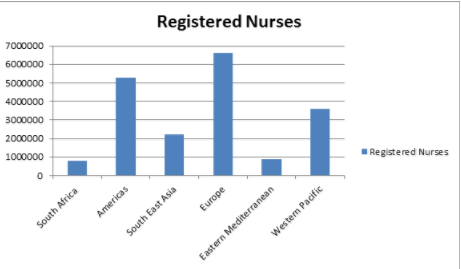
Age Comparison

Major Nursing Associations South Africa:
- South African Nursing Council
- Allied Nursing Association of South Africa
- Society of Private Nurse Practitioners of South Africa
- The Emergency Nurses Society of South Africa: EMSSA
- Democratic Nursing Association South Africa
- Association of Nursing Agencies of South Africa
- Professionals Connect Democratic Nursing Organisation
- Nursing Education Association South Africa
- Occupational Health Nursing Associations
- Northern New Jersey Black Nurses Association
- Overseas Nursing Association.
- African Nursing Organizations
- Neonatal Nurses Association of South Africa
- South African Theatre Nurse Organisation
- Southern African Network of Nurses and Midwives, South Africa
- South African Society of Occupational Health Nursing Practitioners
Major International Nursing Associations:
- Association of Community Health Nursing Educators
- Academy of Medical-Surgical Nurses
- Academy of Neonatal Nursing
- Air & Surface Transport Nurses Association
- American Assembly for Men in Nursing
- Asia Pacific Paediatric Nurses Association
- World Academy of Nursing Science
- Korean Nurses Association
- Malaysian Nurses Association
- Philippine Nurses Association (PNA)
- Singapore Nurses Board
- European Federation of Nurses Associations
- European Federation of Critical Care Nursing Associations
- European Oncology Nursing Society
- Swedish Association of Health Professionals
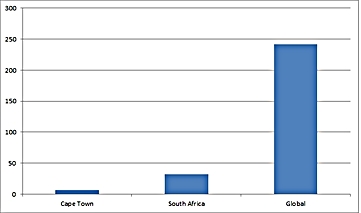
Nursing Education
Nursing Universities in South Africa
- University of Pretoria
- University of Witwatersrand
- Stellenbosch University
- Nelson Mandela University
- University of Western Cape
- Durban University of Technology
- University Of Johannesburg
- Nelson Mandela Metropolitan University
- Tshwane University of Technology
- University of South Africa
- University of Limpopo
- Vaal University of Technology
- University of Venda
- Central University of Technology
- University of Zululand
International Nursing Universities
- University of California
- University of Pennsylvania
- Emory University
- Curtin University
- University of Maryland, Baltimore
- Rush University
- Oregon Health & Science University
- New York University Rory Meyers College of Nursing
- Boston College
- University of Rochester
- University of Miami
- University of Alberta
- King’s College, London
- Deakin University
- Ulster University
- McMaster University
- Case Western Reserve University
- CMC, Vellore
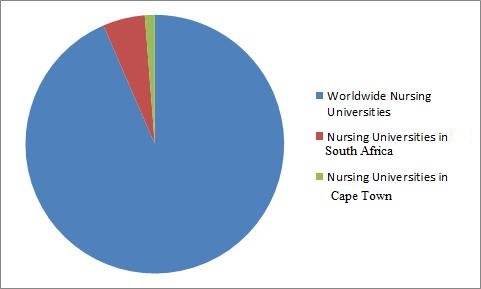
Analysis of Public Health Systems
List of Health Care Facilities South Africa
- Louis Leipoldt Medi-Clinic
- Ermelo Medi-Clinic
- Chris Hani Baragwanath Hospital
- Busamed Gateway Private Hospital
- Charlotte Maxeke Johannesburg Academic Hospital
- Netcare Unitas Hospital
- Groote Schuur Hospital
- Karl Bremer Hospital
- Zuid-Afrikaans Hospital
- Cecilia Makiwane Hospital
- The Red Cross War Memorial Children’s Hospital
- Life Beacon Bay Hospital
- Eugene Marais Hospital
- Netcare Rosebank Hospital
- Worcester Medi-Clinic
List of Global Health Care Facilities
- Cleveland Clinic
- St Jude Children's Research Hospital
- Johns Hopkins Medicine
- Mayo Clinic Scottsdale AZ
- University of Maryland Medical Center
- Massachusetts General Hospital
- Assistance Publique Hôpitaux de Paris
- Buddhist Tzu Chi General Hospital
- INCA Instituto Nacional de Câncer
- University Clinic Heidelberg Universittsklinikum, Heidelberg
- Erasmus Medisch Centrum Universitait Medisch Centrum, Rotterdam
- Xinqiao Hospital Third Military Medical University
- Alberta Health Services
- Centre Hospitalier Universitaire Vaudois Lausanne
- National Hospital Organization, Japan

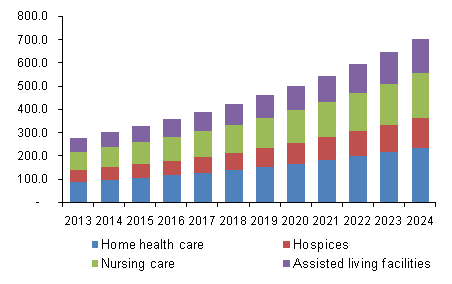
Market Analysis
The Healthcare Industry has been one of the most stable and profitable sectors over the last 5 years with a steady growth rate. Total revenue in this sector is estimated at $129bn and the annual growth rate between 2012 and 2017 is calculated as 1.4% globally. An estimated 1.7 million people are employed in this sector and there are 23056 businesses. The growth rate during 2017-2022 is estimated to increase to around 4.5%. The current average of global profit in this sector is 21.6%.
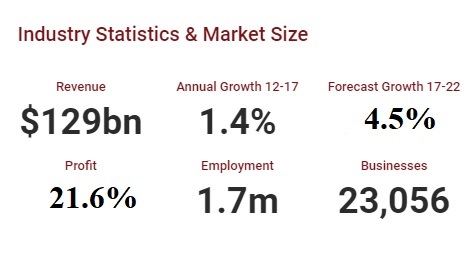
The 23rd World Nurse Practitioner Conference hosted by ME Conferences was held on September 28-29, 2017, at JW. Marriott, Dubai, UAE based on the theme “Bridging Excellence in Nursing and Nursing Practice”. Benevolent response and active participation were received from the Organizing Committee Members along with Scientists, Researchers, Students and leaders from various fields of Nursing, who made this event a grand success.
ME Conferences expresses its gratitude to the conference Honourable Guests and Keynote Speakers includes:
-
Charleen Singh, San Jose State University, USA
-
Federico Calixtro, Roseman University of Health Sciences, USA
-
Amer Alata, Ross University School of Medicine, USA,
-
Nycole Oliver Sparks Health Systems, USA
Similarly, we also extend our appreciation towards our Poster Judge: • Charleen Singh, San Jose State University, USA
The meeting reflected various sessions, in which discussions were held on the following major scientific tracks:
-
Nursing Practice
-
Nursing Education
-
Women Health & Midwifery
-
Pediatric Nursing
-
Clinical nursing
-
Critical care and Emergency Nursing
-
Cardiovascular Nursing
-
Travel Nurse
-
Cancer and Tumour Nurse
-
Nursing Management
-
Nursing Types
-
Dental Nursing
-
Veterinary Nursing
-
Psychiatric Nurse Practitioner
-
Diabetes Nurse
-
Health Care
-
Disaster Nursing
-
Dermatology Nurse
-
Wound Care Nurse
-
Public Health Nurse
-
Gynecology/Obstetrics Nurse
-
Gerontology Nurse
-
Telemedicine and e-Health
ME Conferences offers it’s heartfelt gratitude to the eminent personalities who supported the conference by facilitating the discussion forums. ME Conferences also took the privilege to felicitate the Keynote Speakers, Organizing Committee Members, Chairs and Sponsors who supported this event.
With the grand success of Nurse Practitioner Conference 2017, ME Conferences is proud to announce the International Conference on Community Nursing and Public Health to be held on November 19-21, 2018 in Cape Town, South Africa
See you in Cape Town, South Africa.
For More details visit:https://community.nursingconference.com/
Conference Highlights
- Community Nursing
- Nursing Education
- Community Midwifery and Pregnancy
- Public Health
- Nursing Management
- Paediatric and School Nursing
- Occupational Health Nursing
- Family Nursing and Healthcare
- Geriatric Nursing
- Environment, Health and Safety
- Ambulatory and Emergency Care Nursing
- Military and Combat Nursing
- Epidemiology Nursing and Impact on Public Health
- Community Mental Health and Psychiatry
- Social Outreach and Homeless Nursing Programs
- Community Nurses in Addict Rehabilitation and Prevention of Substance Abuse
- E-Medicine and Telehealth Nursing
- Entrepreneurial Opportunities in Nursing
To share your views and research, please click here to register for the Conference.
To Collaborate Scientific Professionals around the World
| Conference Date | November 19-21, 2018 | ||
| Sponsors & Exhibitors |
|
||
| Speaker Opportunity Closed | Day 1 | Day 2 | Day 3 |
| Poster Opportunity Closed | Click Here to View | ||






